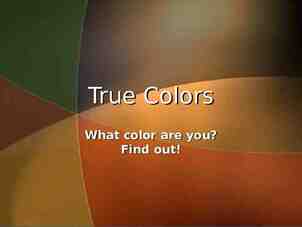8th Grade Forensic Science Image: awittyassniga.tripod/things/fire.jpg
17 Slides3.63 MB
8th Grade Forensic Science Image: http://awittyassniga.tripod.com/things/fire.jpg T. Trimpe/B.Brooks 2006 http://sciencespot.net/
Fire Investigation Terms Fire - Produced when a substance undergoes rapid oxidation involving heat and light. Fire Triangle – Shows the three elements needed to produce and sustain a fire. Flash Point – The lowest temperature to which a substance must be heated in order for the substance to give off vapors which will burn when exposed to a flame or ignition source. Point of Origin – The location where the fire started. Burn patterns –Noticeable patterns created by the fire as it burns. Accelerants – Substances, such as gasoline, paint thinner, and alcohol, that accelerate the burning process. Arson – A fire started deliberately.
Fuel Oxygen Heat Fire The FIRE TRIANGLE represents the three elements needed for fire to occur: heat, fuel, and oxygen. FUEL HEAT OXYGEN
Fuel can be any combustible material in any state of matter - solid, liquid, or gas. Most solids and liquids become a vapor or gas before they will burn. Examples: CLOTHING FURNITURE CURTAINS FLAMMABLE LIQUIDS FUEL HEAT OXYGEN
The air we breathe is about 21% oxygen. Fire requires an atmosphere with at least 16% oxygen. FUEL HEAT OXYGEN
Remember: Fuel Oxygen Heat Fire Heat is the energy necessary to increase the temperature of the fuel to a point where sufficient vapors are given off for ignition to occur. FUEL HEAT Examples: STOVES HEATING APPLIANCES FIREPLACES DAMAGED WIRING OXYGEN
Fire Clues Point of Origin – Burn patterns and other damage can help determine the point of origin, or the location where the fire started. Char Patterns – Created by very hot fires that burn very quickly and move fast along its path, so that there can be sharp lines between what is burned and what isn't. – A char pattern on a door would help an investigator determine which side of the door the fire was on. – A char pattern on the floor would help investigators determine the use of an accelerant and its path. V-Patterns - Fire burns up, in a V-shaped pattern, so a fire that starts at an outlet against a wall leaves a char pattern that points to the origin. – A very narrow V-shape might indicate a fire that was hotter than normal, such as one helped along by an accelerant. – A wide V-shape might indicate a fire that was slow burning. – A U-shape could indicate that there was a "pool of origin" rather than a point of origin, such as might be caused by, say, a puddle of gasoline.
Heat Shadows - Occur when heavy furniture shields part of a wall; can help determine the origin point. Glass - Glass fragments, windows, and light bulbs can provide clues to a fire. – Light bulbs tend to melt toward the heat source, so the "direction of melt" can indicate the direction of the fire. – The shattered or cracked glass of the windows can provide indications as to how a fire burned. – A dark soot layer on the glass could indicate a slow, smoldering fire. – Clear glass with an abnormal pattern of cracking could imply a very hot fire, possibly due to an accelerant. Chimney Effect - Since fire burns upwards, there can be a "chimney effect" where the fire ignites at a point, the superheated gases rise upward and form a fireball, which continues straight up to burn a hole in the ceiling. If the roof is not entirely burnt, and the fire investigator finds such a hole, the origin of the fire could be directly underneath. Color of smoke – Determine what type material was burning Color of flames – Indicates at what temperature the fire was burning.
Fire Investigation Basics Work from the least damaged areas to the most heavily damaged areas. Document with notes, photographs, and videos. Collect evidence (accelerant samples, fire items, and other crime scene evidence.) Interview witnesses Determine the point of origin. Determine the heat source(s). Hypothesize the reasons for the fire.
Havana – Laurel Street Practice Burn Photographs What clues might a fire investigator gain from this photograph? Photos provided by Brock Brooks & the Havana Fire Department
Havana – Laurel Street Practice Burn Photographs Photos provided by Brock Brooks & the Havana Fire Department
Practice Burn Photographs A fire started in the kitchen area does not take long before it is a ball of flame reaching quickly to the ceiling. Fires can easily double in size every 60 seconds, meaning there is little time to extinguish a fire before escape should be your primary goal if trapped. Fire fighters look on as the fire spreads across a room. Source: http://www.ci.east-grand-forks.mn.us/fire/gallery/burn/burn.htm The house is nearly completely consumed.
Accident or Arson? Accidental Nature – Heating System – Electrical appliances – Lightning – Children playing with matches – Smoking Non-Accident Image: Havana Rural Fire Department – Odors – Gas, kerosene, or other accelerants – Furnishing – Removal of personal objects and valuables – Clothing – Check debris for buttons, zippers, etc – Locked windows, blocked doors – Two or more points of origin – Look for inverted v-patterns (can be a sign that an accelerant was used) – Floors charred –Can indicate use of an accelerant – Trailers that lead the fire from one place to another
Arson Facts in America According to the FBI Crime Index, juvenile and adult arson cause an annual average of 560,000 fires, 750 deaths, 3,700 injuries, and 1.5 billion in property loss. 55% of all arson arrests in the US are children under 18. What are Common Motives for Arson? Crime concealment: To conceal another crime such as murder, burglary, or vehicle. Revenge or spite: To get back at someone for a perceived injustice. Monetary Gain: Arson-for-Profit fires are set to burn a building, vehicle, or some other object in order to gain profit from the fire. The profit may come in several forms; from insurance coverage on the property, or from putting a competitor out of business. Malicious Vandalism: Fire set to someone’s property, just to destroy it. Malicious vandalism fires account for the largest percentage of arson fires. These fires are frequently set by juveniles. Mentally Disturbed: Some persons have been found to have an irresistible impulse to set fires. Source: http://www.state.il.us/osfm/Arson/ArsonIsAFelonyCrime.htm
Juvenile Firesetting Fires set by juveniles are usually the result of a child or teenager experimenting with fire with a lack of understanding of the consequences. Others fires may be started by troubled children as a “cry for help” or as acts of vandalism. The facts . In Rochester, New York, a two year old, playing with matches, started a fire that took his life and the lives of five family members. In Roanoke, Virginia, a seven year old boy set fire to a chair in an abandoned building, the fire spread to an adjacent house and trapped an elderly woman. In Passaic, New Jersey, a firefighter was killed and hundreds of people lost their homes in a fire started by a group of teenage boys. These tragic events are not isolated incidents. In a typical year, in the U. S., 300 people are killed and 190 million in property is destroyed in fires set by children. Children themselves are usually the victims of these fires accounting for 85 of every 100 lives lost. Source: http://www.usfa.dhs.gov/downloads/txt/publications/l-240.txt
Arson Charges in Illinois ARSON - Felony - Up to 25,000 fine &/or 3 to 7 Years in jail A person commits arson when, by means of fire or explosive, he knowingly: (a) Damages any real property, or any personal property having a value of 150 or more, of another without his consent; or (b) With intent to defraud an insurer, damages any property or any personal property having a value of 150 or more. AGGRAVATED ARSON - Felony - Up to 25,000 fine &/or 6 to 30 Years in jail A person commits aggravated arson when in the course of committing arson he knowingly damages, partially or totally, any building or structure, including any adjacent building or structure, and (1) he knows or reasonably should know that one or more persons are present therein or (2) any person suffers great bodily harm, or permanent disability or disfigurement as a result of the fire or explosion or (3) a fireman or policeman who is present at the scene acting in the line of duty, is injured as a result of the fire or explosion. RESIDENTIAL ARSON - Felony - Up to 25,000 fine &/or 4 to 15 Years in jail A person commits the offense of residential arson when, in the course of committing an arson, he or she knowingly damages, partially or totally, any building or structure that is the dwelling place of another. Source: http://www.state.il.us/osfm/Arson/Statutes.doc
What can you do to help prevent arson or arson damage? Report suspicious persons and activities that may result in arson. If you have a friend or classmates that has set fires in the past or plans to set a fire, tell an adult – parent, teacher, counselor, police officer, or a fireman. Start or participate in a community watch program with your parents. Install and properly maintain fire alarms in your home and encourage friends and relatives to do the same. Your family should also have a fire escape plan for your home.






















